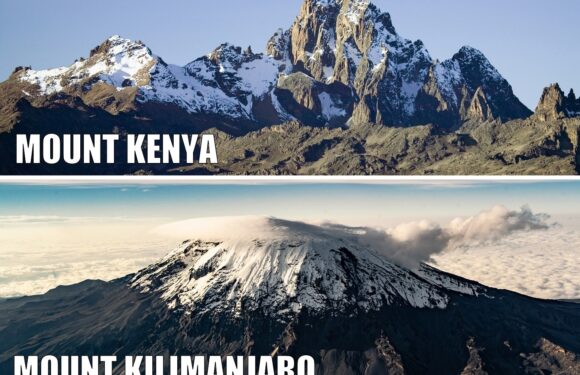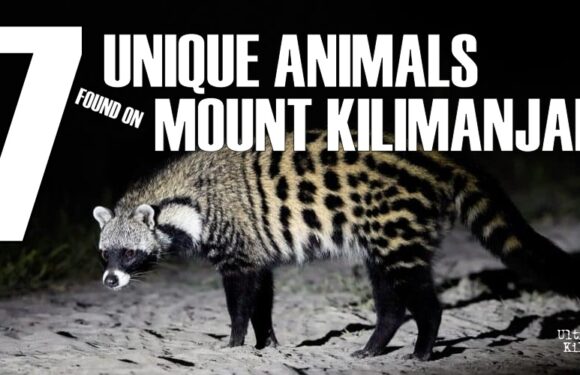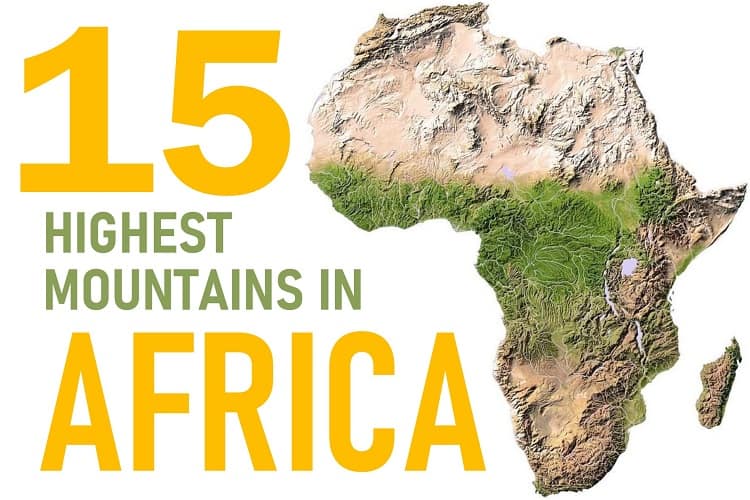
Mount Kilimanjaro is the tallest mountain in Africa, making it one of the famed Seven Summits (the highest peaks on each of the seven continents). In fact, it is the tallest freestanding mountain in the world, meaning that it is not part of a mountain range.
But what are the other highest mountains in Africa?
Let’s take a look below.
What are the Tallest Mountains in Africa?
1. MOUNT KILIMANJARO
Height: 19,341 feet / 5,985 meters
Country: Tanzania

Certainly Mount Kilimanjaro is Africa’s most famous mountain. The name Kilimanjaro is widely believed to mean, “Mountain of Greatness.” Most people have heard of the mountain, even though they might not know exactly where it is (in Tanzania, near the southwestern border of Kenya). It’s a dormant volcano that had its last major eruption 750,000 years ago.
Kilimanjaro has three peaks – Kibo, Mawenzi, and Shira (now collapsed). The summit, named Uhuru Point, rests on Kibo and is 19,341 feet above sea level. Despite its immense size, climbing to the top does not require any technical mountaineering skills.
2. MOUNT KENYA
Height: 17,057 feet / 5,196 meters
Country: Kenya
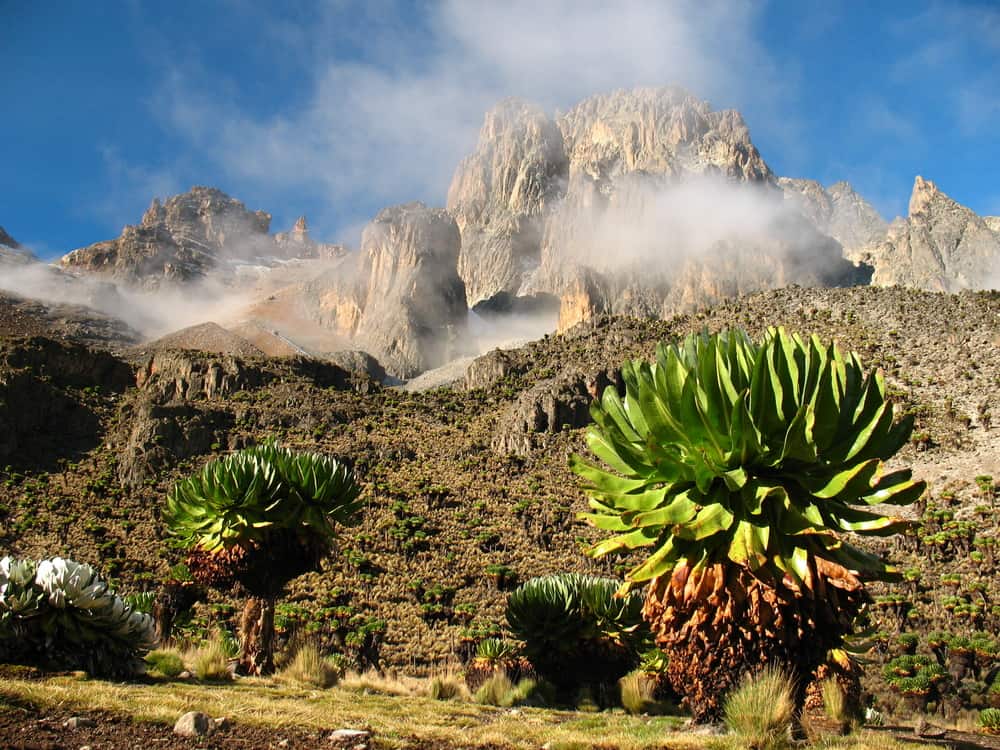
Mount Kenya is the second highest mountain in Africa. The mountain has three high peaks – Batian, Nelion, and Lenana – which were formed by volcanic eruptions. The last eruption was over 2 million years ago. Batian is the tallest peak at 17,057 feet (5,196 meters), while Nelion and Point Lenana measure 17,020 feet (5,187 meters) and 16,354 feet (4,985 meters) respectively. The two tallest peaks require rock climbing skills to conquer, while Point Lenana is a popular hiking route. Because Mount Kenya is located on the equator, the sun rises and sets at almost exactly the same time each day.
3. MOUNT STANLEY
Height: 16,762 feet / 5,109 meters
Country: Uganda and Democratic Republic of Congo

Mount Stanley is the third tallest mountain in Africa. It’s located on the border of Uganda and the Democratic Republic of Congo. Mount Stanley is named for Welsh-American journalist and explorer, Sir Henry Morton Stanley. It is part of the Rwenzori Mountains, also known as “Mountains of the Moon.” The Rwenzori were not made from volcano eruptions, but from tectonic activity. While Kilimanjaro and Mount Kenya are taller, this is known as a more challenging hike due to its wet, boggy terrain and glacier travel. Margherita Peak is the name of the highest point.
4. MOUNT SPEKE
Height: 16,043 feet / 4,890 meters
Country: Uganda

Mount Speke is the second highest mountain in the Rwenzori Mountains. The mountain was named after English explorer John Hanning Speke. It is located close by to Mount Stanley and the journey to the top is similar. However, summiting Mount Speke was formerly an extensive snow climb. But currently it is possible to bypass the glacier entirely. The great glaciers that used to lie on the north side and south side of the peak have sadly disappeared.
5. MOUNT BAKER
Height: 15,892 feet / 4,843 meters
Country: Uganda

Coming in at number five is Mount Baker. Mount Baker is also found in the Rwenzori Mountains and together with Mount Stanley and Mount Speke form a triangle encircling upper Bujuki Valley. The mountain was named after English explorer Sir Samuel Baker. The word “Rwenzori” is a local name which that means “Rain Maker” or “Cloud King,” which is very fitting for this region that receives high rainfall. Mount Baker has multiple jagged peaks along a ridge of which the highest is Edward Peak.
6. MOUNT EMIN
Height: 15,741 feet / 4,798 meters
Country: Democratic Republic of Congo

Mount Emin is the fourth highest mountain in the Rwenzori Mountain range and is located in the Congo, along the border with Uganda. There are two peaks that are approximately the same height, connected by a very narrow ridge. Umberto (15,741 feet / 4,798 meters) is the southern peak and Kraepelin (15,720 feet / 4,791 meters) is a somewhat shorter, northern peak. The mountain was named after German explorer Mehmed Emin Pasha. The mountain has narrow and rocky ridges but are still very accessible for hiking.
7. MOUNT GESSI
Height: 14,980 feet / 4,715 meters
Country: Uganda

Mount Gessi is the fifth highest mountain in the Rwenzori Mountain range. It was named after an Italian explorer Romulo Gessi. This mountain has twin peaks – Iolanda (15,470 feet / 4,715 meters) and Bottego (15,418 feet / 4,699 meters). They were covered in ice and glaciers in the past, but no longer. Mount Gessi can be hiked from both the Democratic Republic of Congo and Uganda.
8. MOUNT LUIGI DI SAVOIA
Height: 14,980 feet / 4,715 meters
Country: Uganda

Mount Luigi di Savoia is the final peak in the Rwenzori Mountain range on our list. This peak is named for Italian mountaineer and Duke of Abruzzi, Prince Luigi Amedeo, who climbed all six of the highest massifs in the range. The mountain is a long ridge with many summits, including Sella Peak (15,180 feet / 4627 meters), Stairs Peak (14,911 feet / 4545 meters), and Weismann Peak (15,157 feet / 4620 meters).
9. MOUNT MERU
Height: 14,980 feet / 4,562 meters
Country: Tanzania

Mount Meru is the second highest mountain in Tanzania. The mountain is located in Arusha National Park, which is about 40 miles (70 kilometers) west of Mount Kilimanjaro. Mount Meru is often overlooked, overshadowed by its big brother. However, it can be climbed in just 3-4 days and serves as a good acclimatization hike before ascending Kilimanjaro. From the summit, called Socialist Peak, you can get a great view into the Ash Cone which had its last serious eruption 100 years ago.
10. MOUNT RAS DASHEN
Height: 14,927 feet / 4,550 meters
Country: Ethiopia

Mount Ras Dashen, also known as Ras Dejen, is the highest peak in Ethiopia. The name comes from a term that means the “general who fights in front of the emperor.” The mountain is located in the Simien Mountains, a range that was formed by ancient lava flows. Ras Dashen is home to thousands of endemic species and a unique ecosystem. Geographers named these highlands the African Alps. The peak can be climbed in as little as two days.
11. MOUNT KARISIMBI
Height: 14,787 feet / 4,507 meters
Country: Rwanda and Democratic Republic of Congo
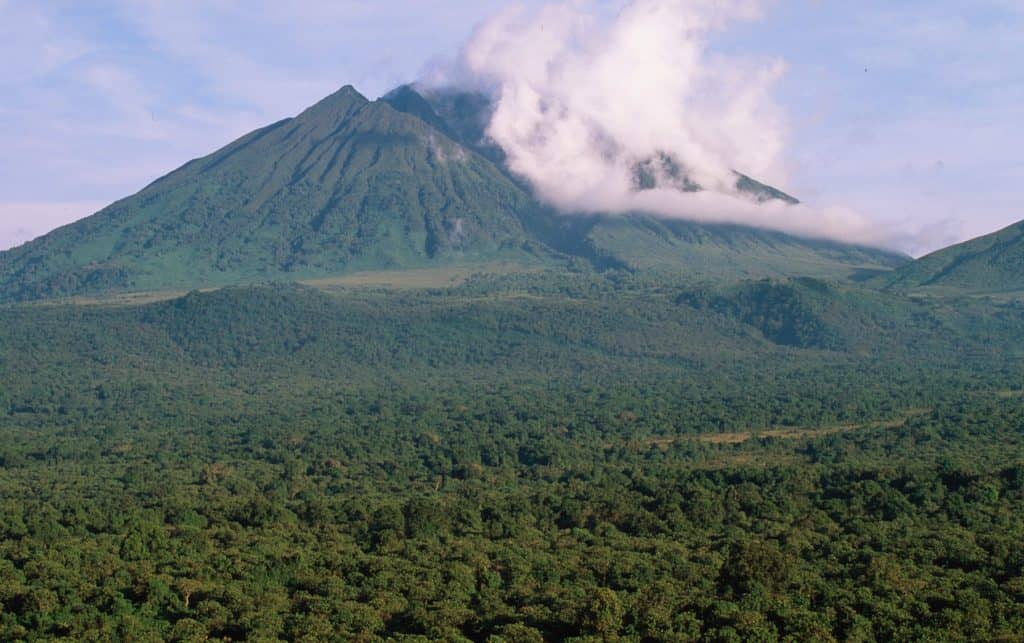
Mount Karisimbi is the highest mountain within the Virunga Mountains. Located along the border between Democratic Republic of Congo and Rwanda, this stratovolcano is the highest of the major volcanoes of the Virunga range. Mount Karisimbi is an inactive volcano. The name means “white shell,” a clear reference to the mountain’s snow cap. Climbing Mount Karisimbi takes 2-3 days. Most visitors combine the hike with a gorilla safari, which Rwanda is famous for. If you’re lucky, you might even see gorillas during your Karisimbi climb!
12. MOUNT ELGON
Height: 14,176 feet / 4,321 meters
Country: Kenya and Uganda
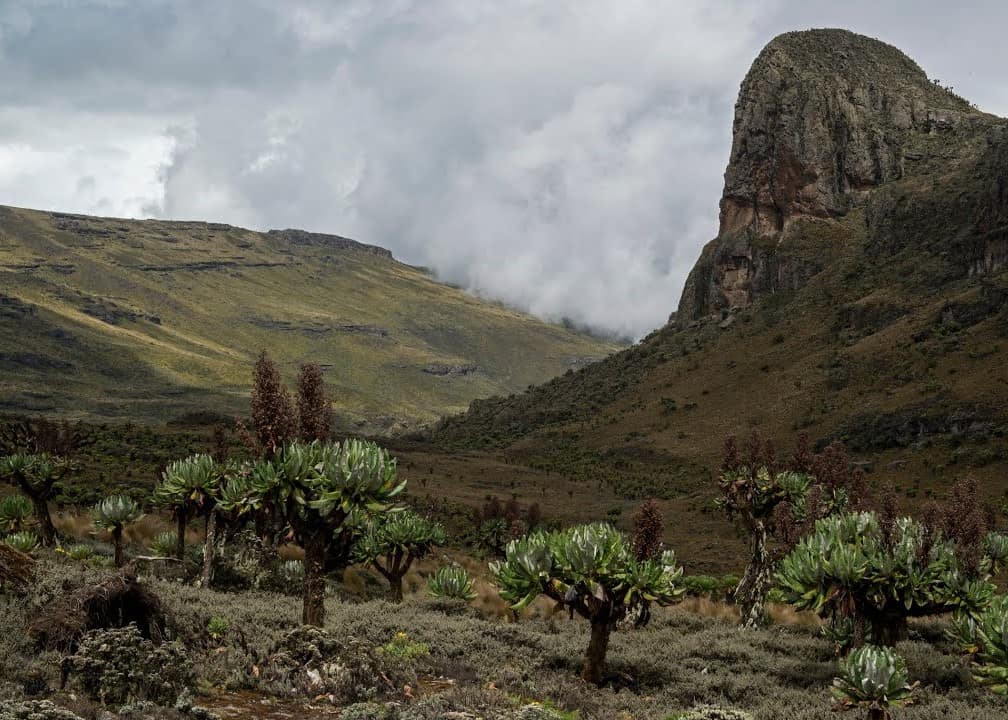
Mount Elgon was once Africa’s highest mountain. However, due to erosion it lost its record height. It last erupted 10 million years ago and is an extinct volcano. Mount Elgon has the largest volcanic base in the world at 2,500 square miles (4,000 square kilometers) and 50 miles (80 kilometers) in diameter. It is the oldest and largest solitary volcanic mountain in East Africa, lying in the middle of the Kenyan and Ugandan border. The summit is named Wagagai Peak. Climbing Mount Elgon takes between 4 to 6 days depending on the trail used.
13. MOUNT TOUBKAL
Height: 13,671 feet / 4,324 meters
Country: Morocco

When most people think of Morocco, they picture dry, desert landscapes. However, between the hot Sahara climate and the Atlantic Ocean lie the Atlas Mountains. This mountain range extends for 460 miles (740 kilometers) from the Atlantic Coast to the Algerian border. Many of the Atlas peaks are taller than 12,000 feet (3,660 meters), including Mount Toubkal. Mount Toubkal is the highest mountain in North Africa, located about an 40 miles (60 kilometers) from Marrakech. It is a 2-3 day non-technical hike across rugged terrain to the summit.
14. MOUNT GUNA
Height: 13,517 feet / 4120 meters
Country: Ethiopia

Mount Guna is located in northern Ethiopia in the Gondar region. The mountain is a shield volcano, a type of volcano named for its low profile. These types of volcanoes are very large and broad, but not very tall. Mount Guna is a source of various rivers in the region including River Gumar and River Rib.
15. MOUNT CHOQA
Height: 13,451 feet / 4,100 meters
Country: Ethiopia
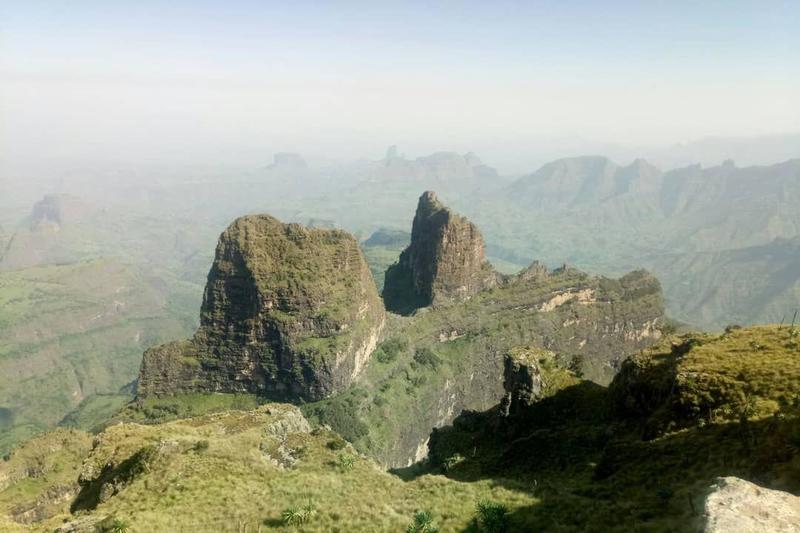
Mount Choqa, sometimes referred to as Mount Choke, is also located in Northern Ethiopia about 75 miles (120 kilometers) south of Mount Guna. It lies north from the Great Rift Valley at the northwestern edge of the Ethiopian plateau. Mount Choqa is part of an ancient volcanic massif known as the Choke Mountains. Mount Choqa by itself contributes more than 10% of the Nile water and is very important to Ethiopia and other countries who depend on the river as a water source. Very few tourists visit this area.
_____





















































